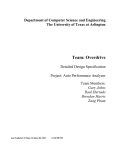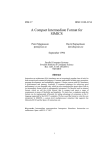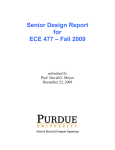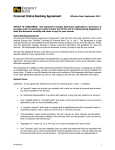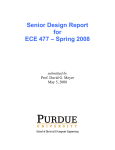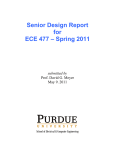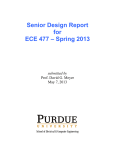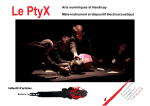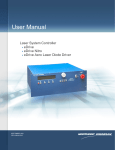Download Senior Design Report for ECE 477 – Fall 2013
Transcript
Senior Design Report for ECE 477 – Fall 2013 submitted by Prof. David G. Meyer December 16, 2013 School of Electrical & Computer Engineering ECE 477 Senior Design Report 12/16/2013 Contents Course Description ……………………………………………………………………………. 1 Course Staff ……………………………………………..……………………………………. 1 Lecture Schedule / Course Calendar ………..………………………………………………… 2 Design Project Specifications / Requirements ……………………………………………..… 4 Design Project Milestones …………………………………………….………………..……. 5 Course Outcomes and Assessment Procedures ……………..……………………………….. 6 Course Grade Determination ………………………………………………………………… 7 Course Assessment Report …………………………………………………………………. 8 Appendix A: Senior Design Reports -ii- ECE 477 Senior Design Report 12/16/2013 Course Description Digital Systems Senior Design Project (ECE 477) is a structured approach to the development and integration of embedded microcontroller hardware and software that provides senior-level students with significant design experience applying microcontrollers to a wide range of embedded systems (e.g., instrumentation, process control, telecommunications, intelligent devices, etc.). The primary objective is to provide practical experience developing integrated hardware and software for embedded microcontroller systems in an environment that models one which students will most likely encounter in industry. One of the unique features of this course is that each team gets to choose their own specific project (subject to some general constraints) and define specific success criteria germane to that project. In general, this approach to senior design provides students with a sense of project ownership as well as heightened motivation to achieve functionality. Course web site: https://engineering.purdue.edu/ece477 Course Staff Name Prof. David Meyer Dr. Mark Johnson George Hadley George Toh Blaine Gardner Joseph Bougher Title / Role Faculty / Project Advisor Faculty / Project Advisor Lab Coordinator Teaching Assistant / Project Consultant Teaching Assistant / Project Consultant Lab Technical Support -1- E-mail Address [email protected] [email protected] [email protected] [email protected] [email protected] [email protected] ECE 477 Senior Design Report Lecture Schedule / Course Calendar -2- 12/16/2013 ECE 477 Senior Design Report 12/16/2013 Design Project Specifications / Requirements Work on the design project is to be completed in teams of four students. The design project topic is flexible, and each group is encouraged to pick a product that uses the strengths and interest areas of their group members. The design must have the following components: • Microcontroller: To help make the project tractable, recommended microcontroller choices include Freescale, PIC, and Atmel variants. Development tools are readily available in lab to support these devices. Further, the devices themselves are relatively low cost and readily available. Optionally, auxiliary processing can be accomplished using a “motherboard”. Examples of these directly supported are Intel Atom and ARM-based platforms. • Interface to Something: The embedded system designed must interface to some other device or devices. It could be a computer, smart phone, tablet, or some other embedded device. Interface standards that can be used include: asynchronous or synchronous serial, parallel, Universal Serial Bus (USB), Bluetooth, Xbee, Firewire, Ethernet, Infrared (IR), Radio Frequency (RF), etc. This requirement has a large amount of freedom. To help with some of the more complex interfaces such as Ethernet and USB, dedicated chips which encapsulate the lowest layers of the interface can be utilized. This makes using these interfaces easier to handle but not necessarily trivial. (NOTE: Interfaces involving A.C. line current require special permission – see the instructor for details.) • Custom printed circuit board: Through the process of the design, each group will be required to draw a detailed schematic. From the schematic, a two-layer printed circuit board will be created. Board etching will be processed by the ECE Department (the first one is “free”, but any subsequent iterations are the team’s responsibility). The team is then responsible for populating the board (solder the parts on the board), and for completing the final stages of debugging and testing on their custom board. • Be of personal interest to at least two team members: It is very difficult to devote the time and energy required to successfully complete a major design project in which you and/or your team members have no personal interest. There are lots of possibilities, ranging from toys and games to “useful and socially redeeming” household items, like audio signal processors and security systems. • Be tractable: You should have a “basic idea” of how to implement your project, and the relative hardware/software complexity involved. For example, you should not design an “internet appliance” if you have no idea how TCP/IP works. Also, plan to use parts that are reasonably priced, have reasonable footprints, and are readily available. Be cognizant of the prototyping limitations associated with surface mount components. • Be neatly packaged: The finished project should be packaged in a reasonably neat, physical sound, environmentally safe fashion. Complete specification and CAD layout of the packaging represents one of the project design components. • Not involve a significant amount of “physical” construction: The primary objective of the project is to learn more about digital system design, not mechanical engineering! Therefore, most of the design work for this project should involve digital hardware and software. -3- ECE 477 Senior Design Report 12/16/2013 Project Proposal: Each group should submit a proposal outlining their design project idea. This proposal should not be wordy or lengthy. It should include your design objectives, design/functionality overview, and project success criteria. The five success criteria common to all projects include the following: • • • • • Create a bill of materials and order/sample all parts needed for the design Develop a complete, accurate, readable schematic of the design Complete a layout and etch a printed circuit board Populate and debug the design on a custom printed circuit board Package the finished product and demonstrate its functionality In addition to the success criteria listed above, a set of five significant project-specific success criteria should be specified. The degree to which these success criteria are achieved will constitute one component of your team’s grade. Forms for the preliminary and final versions of your team’s project proposal are available on the course web site. Use these skeleton files to create your own proposal. Note that the proposal should also include assignment of each team member to one of the design components as well as to one of the professional components of the project. Group Account and Team Webpage: Each team will be assigned an ECN group account to use as a repository for all their project documentation and for hosting a password-protected team web page. The team web page should contain datasheets for all components utilized, the schematic, board layout, software listings, interim reports, presentation slides, etc. It should also contain the individual lab notebooks for each team member as well as the progress reports (prepared in advance of the weekly progress briefings) for each team member. At the end of the semester, each team website will be archived on the course website. Design Review: Part way through the design process, there will be a formal design review. This is a critical part of the design process. In industry, this phase of the design process can often make or break your project. A good design review is one where a design is actively discussed and engineers present concur with the current or amended design. The design review is in some cases the last chance to catch errors before the design is frozen, boards are etched, and hardware is purchased. A friend is not someone who rubber-stamps a design, but rather one who actively challenges the design to confirm the design is correct. Approach the design review from a top-down, bottom-up perspective. First, present a block diagram of your design and explain the functional units. Then drop to the bottom level and explain your design at a schematic level. Be prepared to justify every piece of the design; a perfectly valid answer, however, is applying the recommended circuit from an application note. If you do use a circuit from an application note, have the documentation on hand and be able to produce it. Your grade for the design review will not be based on the number of errors identified in your design. The best engineers make mistakes, and the purpose of the design review is to catch them rather than spend hours of debugging later to find them. The design review will be graded primarily on how well the group understands their design and the professionalism with which they present it. To facilitate the design review process, the class will be split into subgroups that will meet at individually scheduled times. Both the presenters and the assigned reviewers will be evaluated. -4- ECE 477 Senior Design Report 12/16/2013 Design Project Milestones Each group is responsible for setting and adhering to their own schedule; however, there are several important milestones, as listed in the table below. Always “expect the unexpected” and allow for some buffer in your schedule. Budget your time. With proper budgeting, senior design can be a very rewarding and pleasant experience. See Course Calendar for due dates. Week 1 2 3 4 5 6 7 Milestone Deliverables Formulate project ideas: sensors used, microcontroller peripherals needed, motherboard requirements (if applicable), memory requirements, power supply requirements, power source (AC, battery) Research and select major components, including the family of microcontroller (e.g. dsPIC, PIC32, etc.) and power supply components (switching regulator, battery management). Check out a microcontroller development board and write code that exercises various on-chip peripherals (e.g., blink an LED at variable rate specified by analog input voltage, debug via RS 232). Order some parts for prototyping purposes. Formulate PSSC and initial block diagram. Finalize and order major components. Order motherboard (Atom, ARM, etc.) if applicable. Begin prototyping microcontroller interfaces (work on parts of circuit most complex first). Start prototyping power supply circuitry. Begin selecting secondary components (e.g., voltage level translators, specialty diodes, capacitors, resistors, etc.) – note that an RS 232 level translator chip is required for the microcontroller to communicate with a host PC via RS 232). Finish power supply prototyping. Be prepared to demonstrate sensor interfaces. Create a detailed BOM. Start developing schematics and create footprints needed for PCB parts library. Start testing motherboard (if applicable). Create packaging CAD drawings. Continue prototyping interface and support circuitry. Finalize schematic and begin PCB layout. Check footprints created for PCB library against actual components. Finalize PCB layout for Design Review. Continue software development and testing. Prepare for Design Review. Preliminary Project Proposal Final Project Proposal Eagle PCB Tutorial Exercise Design Constraint Analysis Report Packaging Report Schematic Report PCB Report Design Review Presentation Proof-of-Parts, Final Schematic, and Final PCB Layout 8 Practice presentation. Continue software development. 9 Incorporate changes/comments from Design Review. 10 Continue software development and testing. Software Report Begin populating/testing PCB. Test PCB section-by-section as parts are added, porting software as you go – add functions one-by-one so you know what it was that “broke” your code or your board when things stop working. Patent Liability Analysis Report Reliability and Safety Analysis Report Ethical/ Environmental Impact Analysis Report 11 12 13 14 15 16 Finalize packaging and system integration. Start assembling and editing Final Report. Create PSSC demo video. Create Poster and Senior Design Report. Finish editing Final Report. Prepare for Final Presentation. Submit project deliverables. Practice Final Presentation. -5- Poster PSSC Demo Video Senior Design Report, User Manual, Final Presentation ECE 477 Senior Design Report 12/16/2013 Learning Outcomes/Objectives and Assessment Procedures In order to successfully fulfill the course requirements and receive a passing grade, each student is expected to demonstrate the following outcomes: (i) an ability to apply knowledge obtained in earlier coursework and to obtain new knowledge necessary to design and test a microcontroller-based digital system (ii) an understanding of the engineering design process (iii) an ability to function on a multidisciplinary team (iv) an awareness of professional and ethical responsibility (v) an ability to communicate effectively, in both oral and written form The following instruments will be used to assess the extent to which these outcomes are demonstrated (the forms used to “score” each item are available on the course web site): Outcome (i) (ii) (iii) (iv) (v) Evaluation Instruments Used Design Component Homework Individual Lab Notebooks Success Criteria Satisfaction (general and project-specific) Professional Component Homework Formal Design Review, Final Presentation, and Final Report You will receive 1% bonus credit for each course outcome you successfully demonstrate. Demonstration of Outcome (i) will be based on the satisfaction of the design component homework, for which a minimum score of 60% will be required to establish basic competency. Demonstration of Outcome (ii) will be based on the individual lab notebook, for which a minimum score of 60% will be required to establish basic competency. Demonstration of Outcome (iii) will be based on satisfaction of 100% of the general success criteria and a minimum of 60% (3 out of 5) of the project-specific success criteria (PSSC). Note: If a “motherboard” is used, at least 2 of the 3 “passing PSSC” must involve functions implemented on the custom PCB. Demonstration of Outcome (iv) will be based on the professional component homework, for which a minimum score of 60% will be required to establish basic competency. Demonstration of Outcome (v) will be based on the Design Review, the Final Presentation, and the Final Report. A minimum score of 60% on the Design Review and a minimum score of 60% on the Final Report and a minimum score of 60% on the Final Presentation will be required to establish basic competency. -6- ECE 477 Senior Design Report 12/16/2013 Course Grade Determination Homework: Several “homeworks” will be assigned related to key stages of the design project. Some of the assignments will be completed as a team (0, 1, 7, 13, 15, 16, 17), three will be completed individually (2, 8, 14), and the remainder will be completed by a selected team member (one from the set {4, 5, 6, 9} and one from the set {3, 10, 11, 12}). 1. 2. 3. 4. 5. 6. 7. 8. 9. 10. 11. 12. 13. 14. 15. 16. 17. 18. These assignments are due Team Building and Project Idea on the prescribed due dates Project Proposal (typically Fridays) at NOON. PCB Tutorial The following penalties will be Design Constraint Analysis and Component Selection Rationale applied for work submitted Packaging Specifications and Design late: Hardware Design Narrative/Preliminary Schematic 10% if submitted no more PCB Design Narrative/Preliminary PCB Layout than 24 hours late PCB Submission, Final Schematic, and Parts Acquisition/Fit 20% if submitted no more Peer Review – Midterm than 48 hours late Software Design Narrative, and Documentation 30% if submitted no more Patent Liability Analysis than 72 hours late Reliability and Safety Analysis 100% if submitted any Ethical/Environmental Impact Analysis later User Manual Peer Review – Final These assignments are all due on Monday, 12/9, at 5:00 PM. Late Senior Design Report penalties will be assessed per above late policy. However, these Final Report materials will NOT be accepted at all after 5:00 PM on Thursday, 12/12. Poster Grade Determination: Your course grade will be based on team effort (40%) as well as your individual contributions (60%), as follows: TEAM COMPONENTS (40% of total) distribution of team component: 20.0% Project Success Criteria Satisfaction* 15.0% Design Review* 15.0% Final Presentation* 15.0% Final Report* 10.0% System Integration and Packaging 10.0% Senior Design Report 5.0% User Manual 5.0% Poster 5.0% PCB Proof-of-Parts * items directly related to outcome assessment INDIVIDUAL COMPONENTS (60% of tot.) distribution of individual component 20.0% Laboratory Design Notebook* 20.0% Design Component Report* 20.0% Professional Component Report* 10.0% Significance of Individual Contribution 10.0% Accountability Quizzes (10) 5.0% Midterm & Final Confidential Peer Reviews 5.0% Design Review and Final Presentation Peer Eval 5.0% PCB Tutorial 2.5% Class Participation - Clicker Exercises 2.5% Class Participation - Team Exercises Your Raw Weighted Percentage (RWP) will be calculated based on the weights, above, and then "curved" (i.e., mean-shifted) with respect to the upper percentile of the class to obtain a Normalized Weighted Percentage (NWP). Equal-width cutoffs will then be applied based on the Windowed Standard Deviation (WSD) of the raw class scores; the minimum Cutoff Width Factor (CWF) used will be 10 (i.e., nominal cutoffs for A-B-C-D will be 90-80-70-60, respectively). Letter grades in the upper 30% of each range will have a “+” designation, and those that fall in the lower 30% of each range will have a “−” designation. Incompletes and Conditional Failures: A grade of “I” or “E” will be given only for cases in which there are documented medical or family emergencies that prevent a student from completing required course work by the end of the semester. Note that University Regulations stipulate that a student must be passing in order to qualify for a grade of “I” or “E”. -7- ECE 477 Senior Design Report 12/16/2013 Course Assessment Report At the senior design level, our expectation is that 100% of the students who receive a passing grade should be able to effectively demonstrate all of the learning objectives based on a passing threshold of 60%. Learning Objective 2 (based on the laboratory design notebook maintained by each student) has perennially been the most troublesome to effectively demonstrate. This failure rate should be lower. This semester, we also had issues with a couple of teams that failed to achieve the minimum acceptable level of functionality (Learning Objective 3). Average Outcome Scores and Outcome Demonstration Statistics for ECE 477 – Fall 2013 Outcome # 1 Avg Score: 87.0% Passed: 31/ 31 = 100.00% Failed: 0/ 31 = 0.00% Outcome # 2 Avg Score: 74.6% Passed: 26/ 31 = 83.87% Failed: 5/ 31 = 16.13% Outcome # 3 Avg Score: 78.1% Passed: 23/ 31 = 74.19% Failed: 8/ 31 = 25.81% Outcome # 4 Avg Score: 86.4% Passed: 31/ 31 = 100.00% Failed: 0/ 31 = 0.00% Outcome # 5 Avg Score: 88.0% Passed: 30/ 31 = 96.77% Failed: 1/ 31 = 3.23% Demonstrated all five outcomes based on primary assessment: 18/ 31 = 58.06% -8- ECE 477 Senior Design Report Appendix A: Senior Design Reports -9- 12/16/2013 ECE 477 Senior Design Report 12/16/2013 Purdue ECE Senior Design Semester Report Course Number and Title Semester / Year Advisors Team Number Project Title ECE 477 Digital Systems Senior Design Project Fall 2013 George Hadley, Dr. Mark Johnson, Prof. Dave Meyer 1 squaDRONE Senior Design Students – Team Composition Name Major Dennis Lazar EE Andrew Kasha Camille Chang EE CmpE Andrew Boldt EE Area(s) of Expertise Utilized in Project Code Optimization, Algorithms, & Team Leadership Circuit Design & Hardware Interfacing Wireless Communication & Android Development Sensor & Control Software Expected Graduation Date May 2014 December 2013 May 2014 May 2014 Project Description: (a) Summary of the project, including customer, purpose, specifications, and a summary of the approach. The squaDRONE is a semi-autonomous quadcopter designed with advanced GPS, bluetooth, and autopilot capabilities. The goal of the project was to create a multi-rotor craft that could be controlled simply through an Android device without significant need for stabilization by the user. The intended customers are anyone with an interest in hobby flight, whether amateurs or experienced pilots. The system consists of the quadcopter and an app that can be installed on any bluetooth-supported Android device. Bluetooth enables communication between the copter and Android device; a GPS module provides real-time positioning of the device as well as fly-bywaypoint capabilities. A magnetometer measures the compass heading of the copter, and a stock KK2.0 flight controller handles flight stabilization. The copter is capable of both auto takeoff and landing. (b) Description of how the project built upon the knowledge and skills acquired in earlier ECE coursework. This project is very multidisciplinary in nature. It requires an understanding of motors, feedback controllers, embedded programming, Android development, and even mechanics. An understanding of motor and motor control was necessary to determine which motors would fit our criteria and which speed controllers can be used to drive the motors. An understanding of feedback controllers was vital during our flight controller calibrations. An understanding of how gains and limits should be adjusted allowed us to calibrate effectively. Due to the network of components utilized in the project, embedded programming was vital for communications and proper control from an Android device. Obviously, to create a suitable Android application required a knowledge of the complex Android Development Kit. Finally, a good mechanical grasp was important for packaging and keeping the project running. -10- ECE 477 Senior Design Report 12/16/2013 (c) Description of what new technical knowledge and skills, if any, were acquired in doing the project. Many important concepts were learned in the making of our project, ranging from proper capacitor placement to clock management. Many of our roadblocks were solved by simply initializing the modules correctly once we learned the proper reasons behind them. One of our biggest issues when running code was optimization, which became a large problem when we incorporated all of the sensors running at once. This slowed down the control so much that the quadcopter was virtually not flyable. By doing code optimization, we made it almost instantaneous control. (d) Description of how the engineering design process was incorporated into the project. Reference must be made to the following fundamental steps of the design process: establishment of objectives and criteria, analysis, synthesis, construction, testing, and evaluation. The engineering design process began with the establishment of the project idea at the start of the semester, an Android-controlled quadcopter with a wide array of advanced features. Once the overarching goal for the project was laid out, we formulated our success criteria based on estimations of feasibility given our knowledge, our resources, and the time available for the semester. After selecting success criteria, the specific design constraints were examined to guide the component selection. This was facilitated by breaking the necessary functions into sub-systems using a block diagram in order to simplify the approach. We compared a wide array of components, choosing our microcontroller and external modules based on the issues considered in the design constraint analysis; while this was happening, the Android application was being developed for testing with a PIC24F prototype board. Once our components were selected, the focus of the work diverged into the synthesis phase. Code was developed and tested on breadboards using a development board while the schematics and PCB layout were drawn up. The dual nature of this division facilitated the routing of the PCB by simulating the necessary module interconnections using the prototyping board. During construction, the quadcopter frame, motors, ESCs, etc were assembled; similarly, the PCB was populated and debugged. While this took place, the embedded code was finalized with the development board. Next, in the testing phase, the individual subsystems were trialed and debugged separately on the copter before the entire system was tested. Once each subsystem was verified, the evaluation phase began. The completion of each PSSC was demonstrated individually to the satisfaction of the evaluators and the team. (e) Summary of how realistic design constraints were incorporated into the project (consideration of most of the following is required: economic, environmental, ethical, health & safety, social, political, sustainability, and manufacturability constraints). Economic: Most quadcopters are valued around $300 to $600. With the extra features that we are providing, we had an economic constraint of around $500 to be competitive on the market. The prototyping cost was expected to be higher especially for this project due to the potential of breaks and cracks during the testing. Environmental: While in use, our project has a very minimal environmental impact. The majority of the environmental impact resides during manufacturing and during disposal. So, we are constrained to choosing products that are environmentally friendly during manufacturing and disposal. The frame and PCBs are the most prone to cause environmental damages. To avoid such problems, we can simply optimize our circuitry to utilize the smallest PCB and use a frame that is environmentally friendly. -11- ECE 477 Senior Design Report 12/16/2013 Ethical: A quadcopter can easily be used unethically. The biggest concern would involve privacy. Typically residents do not have privacy shielding at heights that the quadcopter is capable of flying at. As a result, privacy can easily be invaded with a quadcopter, especially if a camera is strapped to the bottom, which is frequently done. With regards to constraints, it is almost unavoidable. Few packaging choices can be made to prevent misuse, however misuse is inevitable. Health & Safety: Safety was the number one priority in building the quadcopter. In the event of a quadcopter malfunction, many very dangerous things could occur. The team mitigated any of these problems to the best of our abilities, but there is an inherent danger in using a device that spins extremely sharp blades at very high speeds. Steps including hover failsafe’s and auto-disarming were the first concepts programmed into the device. Social: Social implications can easily arise with use of a quadcopter, or any flying device for that matter. The quadcopter utilizes four rotating propellers that can be very dangerous. Socially incorrect use of the quadcopter can lead to injuries or privacy invasions. As a design constraint it is the utmost importance to package the quadcopter in such a way that safety risks are reduced. Obviously, users will always have the ability to misuse the quadcopter even with specialized packaging, but these instances are almost unavoidable. Political: A quadcopter can and is often referred to as a drone. Drones are quite a large political issue nowadays. They can be used for war, battle, spying, crowd control, etc. This would involve modifications or additions to the quadcopter which, as mentioned, is very difficult to control. Sustainability: The team approached the project with sustainability in mind. Code was commented and written in a way for easy modifiability in future applications. The hardware is easily modified and replaced. This makes for easy repairs. Manufacturability: Manufacturing of the quadcopter is fairly simple and can be constructed from bottom up. Manufacturing constraints are mainly involved with environmental issues. (f) Description of the multidisciplinary nature of the project. The project encompassed numerous aspects of engineering. Mechanical, electrical, aeronautical, and industrial engineering areas were considered and used. The frame considered mechanical engineering aspects in the stress and strain analysis needed for the bending the frame endured during operation. We had to careful select a frame that would have a bit of bend the arms would not break during flight. Electrical engineering presented the bulk of the work in regards to the controls, embedded systems, hardware design, and power consumption. Aeronautical analysis was needed when calculating proper lift rates in conjunction with the flight control algorithms regarding throttle. The industrial engineering area came into play when designing the android app due to human factors. (g) Description of project deliverables and their final status. We purchased all of the components to build a quadcopter that can be operated by a wireless transmitter. These components include a frame, four motors, four propellers, four electronic speed controllers, a battery, a flight controller, a receiver, and a transmitter. The transmitter is a typical RC controller that can be used to drive the quadcopter. Upon arrival of the components, we were able to put the parts together and obtain decently stable flight. -12- ECE 477 Senior Design Report 12/16/2013 Part of our goal was to add extra sensors and modules that would increase the functionality of the quadcopter. Firstly, the bluetooth module was added to allow control from an Android device rather than an RC controller. The Bluetooth module was fully integrated into the quadcopter. It works flawlessly sending and receiving data in both directions. The Bluetooth module currently lets us receive data transmitted from the microcontroller onboard the quadcopter, such as GPS coordinates, battery levels, altitude, heading, etc. The microcontroller can also receive commands transmitted from the Android device and act upon each command. With the Bluetooth fully functional we were able to send desired data from the GPS module to the Android device to fairly accurately display the quadcopter location on Google maps. Depending on the day, we were able to get either within at least 4 meters of accuracy and even up to 1 meter of accuracy at times. The GPS module was also capable of determining direction to a waypoint. The Bluetooth also allowed us to transmit the status of the battery to the Android tablet. The battery voltage was determined by the microcontroller through an A/D channel and a status was sent through Bluetooth. The battery indicators were very convenient for us and were very successful. The voltage reading was always within 0.1 volts of the actual voltage, which was more than enough accuracy that was needed. Overall integrating the sensor modules with the quadcopter was very successful. Two other goals we had involved quadcopter flight: auto take-off/land and waypoint navigation. We were able to get stable flight through the RC controller, however when more components were added to the packaging and control was transferred over to the Android device, we encountered stabilization issues. However, when tethered to remove potential stabilization flaws, the quadcopter was able to perform an auto take-off routine, hover, and finally an auto land routine very successfully. When it was free to fly, it was also able to perform the routines successfully but there was a lot of variability and drifting involved. Similarly when operating in waypoint navigation, the quadcopter would perform the correct maneuvers, but drift and stabilization issues would throw it off course. Overall, the quadcopter was fairly successful given the amount of time that was provided. If the team had more time, the flight controller could have been fine tuned to work perfectly with the packaging and Android device. It takes time to calibrate perfectly and due to frequent packaging changes, there were a lot of calibration changes that had to be made. -13- ECE 477 Senior Design Report 12/16/2013 Purdue ECE Senior Design Semester Report Course Number and Title Semester / Year Advisors Team Number Project Title ECE 477 Digital Systems Senior Design Project Fall 2013 George Hadley, Dr. Mark Johnson, Prof. Dave Meyer 2 Ram Cab Phased Array Parking System Senior Design Students – Team Composition Name Alex Gottsov Seth Kohler Todd Scaminaci Kyle Brockhoff Major Area(s) of Expertise Utilized in Project EE EE EE CmpE Expected Graduation Date May 2014 May 2014 May 2014 May 2014 Hardware and circuit design* Hardware and circuit design, test systems* Software development, circuit design* Software development, hardware debugging* *While team members had specialties, all contributed heavily to all aspects of the project. Project Description: (a) Summary of the project, including customer, purpose, specifications, and a summary of the approach. The Ram Cab parking system is an aftermarket parking assist system designed specifically for Chrysler for use on their Ram Chassis Cab line of trucks, but would be easily adaptable for other vehicles. As an aftermarket system, the project was designed to be easy to install, to work with virtually any configuration of vehicle, and to require little to no calibration for use. The project consists of several parts: 1) An ultrasonic phased array module mounted in the rear of the vehicle, typically near the trailer hitch draw bar slot. Using a phased array allows for directional detection: unlike conventional parking sensors, a phased array informs the driver not only the distance to an obstacle, but it’s direction as well. Phased arrays work by offsetting the phase of the signal sent to each element in the array by a predetermined amount. The phase offset between elements “steers” the beam front, effectively giving directional control. The rear module is linked to the cabin unit (see #3) wirelessly, allowing for ease of installation. 2) An ultrasonic sensor bar mounted in the front of the vehicle, typically above the front license plate holder. This sensor bar contains 4 ultrasonic distance measuring modules. The front bar does not utilize a phased array in order to keep costs down and to ease computational strain on the microcontroller. It was reasoned that the driver is at least aware of obstacles in the front of the vehicle; and merely needs to know how far away they are. For instance, when pulling in to a space in a parking garage, the driver is aware of a wall in front of the vehicle, but would like to know how much further to pull into the spot. A phased array was used in the rear because it is assumed that the driver is far less able to see obstacles behind the vehicle, and having directional information is exceedingly useful for this blind spot. The front sensor bar is hard wired to the rear sensor module, as data rates on the wireless module was not fast enough. -14- ECE 477 3) Senior Design Report 12/16/2013 A cabin display unit that displays all relevant information to the driver via an LCD screen. In addition, the module contains a buzzer that alerts the driver of imminent threats around the vehicle. The LCD screen automatically dims based on ambient brightness. The method of operation for the system is fairly straightforward: a pulse (42 kHz for the front bar and 25kHz for the rear module) is produced by an ultrasonic transducer, and a microphone (ultrasonic receiver) positioned near the transducer(s) listens for the pulse to bounce off objects and return. The time that the pulse takes to return is equal to twice the distance to the obstacle it bounces off (because the sound must travel out and back). For the front sensor bar, this is the entire method of operation; the system receives a simple distance measurement. The rear array uses the same principle, with multiple phase-shifted pulses sent to several transducers at once. This directs the beam of ultrasound in a predetermined direction; allowing the system to determine both distance and direction. (b) Description of how the project built upon the knowledge and skills acquired in earlier ECE coursework. The heart of the project is the microcontroller(s) (one in the rear array and one in the display module). The knowledge necessary to work with the microcontroller is largely based on ECE 362 (interfacing to ATD, PWM, input capture, SPI, digital I/O, DMA, etc.), and ECE 264, 364, and 368 (programming and data structures). The knowledge necessary for designing the op-amp RX/TX circuits came largely from lab work in ECE 207, 208, and 323 as well as filter design knowledge obtained in ECE 201 and 202 . (c) Description of what new technical knowledge and skills, if any, were acquired in doing the project. This project gave the team members new insight into the operation of phased arrays; an area that none were particularly familiar with to begin with. The project also required team members to develop and refine debugging skills for both hardware and software; many issues were prevalent throughout design. In addition, existing skills were honed and improved. (d) Description of how the engineering design process was incorporated into the project. Reference must be made to the following fundamental steps of the design process: establishment of objectives and criteria, analysis, synthesis, construction, testing, and evaluation. Objectives and Criteria: the objectives for the project were laid out by Chrysler, and refined by the team in order to meet course requirements as well, and to design a functional, useful system. Analysis: after establishing specific features of the system , the team began to discuss and test ways of accomplishing those objectives: for example, the phased array concept was partially implemented to facilitate adaptability, a criteria set out by Chrysler. After initial analysis, the team began in depth design and testing (synthesis) to evaluate the feasibility of initial proposals. It was at this stage that the LCD was implemented to replace the previous display idea: and LED array. Construction, testing, and evaluation all took place more or less concurrently; to ensure the best functioning product; the project was built in stages, and tested and evaluated at each stage. (e) Summary of how realistic design constraints were incorporated into the project (consideration of most of the following is required: economic, environmental, ethical, health & safety, social, political, sustainability, and manufacturability constraints). -15- ECE 477 Senior Design Report 12/16/2013 Economic: Throughout the design process, components were selected and analyzed based on cost and economies of scale; for instance, readily available project boxes were selected to minimize prototyping costs. The PIC32MX340F512H was selected over a more powerful alternative because of significant cost savings. As part of the deliverables for Chrysler, cost was a huge factor as the system will be mass produced and sold as an aftermarket addition. Environmental: Unfortunately, prototyping tends to be a fairly inefficient process, and inefficient processes tend to have a greater impact on the environment. However, steps were taken to try and minimize this impact; significant effort was put into minimizing the size of the PCB, for example. For final design considerations, however, other steps could be taken. For one, all lead free solder would be used, and manufacture of the device would be limited to facilities with a responsible environmental policy. In addition to these active steps, future design iterations would undoubtedly result in smaller, more optimized PCBs, and smaller packaging. Ethical: With a project such as this, the line between ethical and health and safety concerns is somewhat blurred; however steps can be taken in order to produce the system in the most ethical way possible. For instance, as stated above, the device could be manufactured by responsible facilities. In addition, the device would undergo extensive testing to ensure that the safest, most reliable product is sent to market. Health & Safety: With any system that involves automobiles, safety is of the utmost concern. To maximize safety, this product should come with sufficient warning labels and instructions to ensure that the product is installed and operated in the safest way possible. In addition, the product is designed to alert the user of the possibility of inaccurate readings or functionality issues; for instance, a warning if wireless communication is severed. In addition, the product is designed to be very difficult to install improperly. Also, to ensure that the driver is alert, the system utilizes an audible alarm in addition to an LCD. Social: The designers of this project foresee several social benefits of this system. If manufactured and installed on thousands or tens of thousands of vehicles, it is conceivable that this system might prevent a significant amount of property damage (to vehicles and obstacles), as well as (hopefully) bodily injury or harm caused from vehicles backing into pedestrians or animals. Political: There should not be any political issues that arise due to this project; there was no military research or technology used, and prior art was researched to reduce the possibility of patent infringement. Sustainability: As noted in the environmental and ethical considerations section, many parts of the project were designed with sustainability and optimization in mind. Manufacturability: For the prototype, a blend of surface mount and through-hole components was used to balance adaptability with PCB size; through hole components are easier to test and diagnose. For final versions, all surface-mount components would be used to increase manufacturability. -16- ECE 477 (f) Senior Design Report 12/16/2013 Description of the multidisciplinary nature of the project. The nature of this project demands a wide range of skills; CAD design for the packaging and PCB schematic/layout, good soldering skills, some mechanical design experience for packaging and mounting, a tremendous amount of hardware and software design, as well as debugging. In addition to previously mentioned skills, technical writing skills were utilized in completing all design component and professional component documents. Presentation skills were honed as well, with each team member giving individual presentations and working together during team presentations. (g) Description of project deliverables and their final status. As of 1:00 PM on 12/9/2013, the project successfully fulfills the following PSSCs in final packaging: “an ability to convey distance to an object in a meaningful, visual way”, “an ability to convey distance to an object in an audible way via a speaker”, and “an ability to utilize wireless communication between modules”. In addition, “an ability to determine obstacle location and distance using a phased array” has been proven in preliminary form. The team is actively working to fulfill the remainder of the success criteria. In terms of deliverables for Chrysler, we are working to finish our final report to include specifics that Chrysler requested that are not required for the class. We need to finish documentation and updates to many components, as Chrysler may take this design and implement it on RAM chassis cabs in the near future. -17- ECE 477 Senior Design Report 12/16/2013 Purdue ECE Senior Design Semester Report Course Number and Title Semester / Year Advisors Team Number Project Title Name David Loder Matt Friede Ammanuel Abraham Joseph Idstein ECE 477 Digital Systems Senior Design Project Fall 2013 George Hadley, Dr. Mark Johnson, Prof. Dave Meyer 3 Smart Inductive Charging Car System (SICCS) Senior Design Students – Team Composition Area(s) of Expertise Utilized in Major Project EE Power Transfer, SOC Tracking CmpE Software, Interfacing EE PCB Design CmpE Packaging Expected Graduation Date May 2014 May 2014 Fall 2013 May 2014 Project Description: (a) Summary of the project, including customer, purpose, specifications, and a summary of the approach. S.I.C.C.S is a concept design for a system of multiple RC vehicles. The project consists of two parts. The first is a wireless charging station. This station has a user interface to select a charging mode such as charge time or percent charge. It then monitors the power transferred to the car. The other is a module that can be attached to an RC car that allows for the vehicle to wirelessly charge its battery, monitor that battery life, and provide warning when the vehicle is too far from the charging station. The car communicates with the charging station in order to authenticate itself with the station and share charging information. If the car is not authenticated, it is not able to charge at the station. (b) Description of how the project built upon the knowledge and skills acquired in earlier ECE coursework. Designing and building the S.I.C.C.S took a great combination of hardware and software knowledge. Understanding of timing diagrams and reading IC data sheets was critical and was learned in ECE 362. Breaking apart data types for transmitting floating point values across Bluetooth as characters was a skill learned in ECE 264. This was important for communicating the state of charge between the vehicle and the charging station. This project used UART for many device interfaces including LCD, Bluetooth, and GPS. The UART communication protocol was taught in ECE 337. All of these are more advanced and specific topics; however, the general knowledge from earlier courses such as 201 and 270 helped in the overall understanding of the project. (c) Description of what new technical knowledge and skills, if any, were acquired in doing the project. Throughout the project many new skills were gained. The most obvious of these was the skill to design a PCB. Along with that was the use of new tools such as Eagle. Also, how to use a new IDE for development on PICs was learned. In order to interface with the GPS, it was required to learn about the NMEA protocol that is standard across most GPS devices. -18- ECE 477 Senior Design Report 12/16/2013 (d) Description of how the engineering design process was incorporated into the project. Reference must be made to the following fundamental steps of the design process: establishment of objectives and criteria, analysis, synthesis, construction, testing, and evaluation. The engineering design process was central to this project. Once the main idea for the project was well defined, a couple weeks were spent establishing the PSSCs. These PSSCs were the objectives for the project. The PSSCs were refined as more research was done on available parts and feasibility of certain functions. (e) Summary of how realistic design constraints were incorporated into the project (consideration of most of the following is required: economic, environmental, ethical, health & safety, social, political, sustainability, and manufacturability constraints). Economic: One of the biggest challenges in marketing this product would be the power loss over the inductive charging link when compared to a wired charging system. This additional cost would have to be pushed onto the purchaser and operator of the charging system. In order to minimize this effect, the Qi standard was chosen because of its high power transfer efficiencies. Environmental: Environmental impact is one of the most important features of this project. As electric vehicles are more efficient than gasoline vehicles, a convenient system for charging would encourage more use. However, inductive charging is less efficient than wired charging, and this environmental impact must be accounted for. For this reason, a Qi standard system was used because of the high efficiencies that reach 70%. Ethical: One ethical design consideration was the metering of charge given to the user. The system currently bills the user based on charge delivered to the batteries, rather than how much is used at the station. This is a much more ethical approach so the customer does not get charged for the energy that is wasted in the process. Another ethical concern also was proper disposal of the batteries; for this reason the batteries were mounted on the bottom of the vehicle, rather than inside the enclosure, to allow easy removal and disposal. Health & Safety: The biggest safety concern with this project is the electric shock hazard from the high AC voltages used for inductive power transfer. For this reason, an inductive transfer system was selected that came with the coils enclosed and insulated so minimize potential of electric shock for the user. Social: This entire project could have been considered to have a social aspect of how electrical vehicles are becoming more common and more desirable. While not the immediate future it is a generally accepted notion that we, as a human race, will not be able to drive gasoline powered cars forever and will have to make the switch from gas powered cars to electric cars. Political: Federal and state subsidies for electric vehicles are one of more controversial issues today. Given this current support, this allows the product to be priced at a higher point than normal to boost profit margins. Sustainability: The major issue with sustainability in this project is the recycling of the battery packs used on the vehicle system. If it were to be taken to market in a commercial vehicle, a battery pack should be selected that is easily recyclable. This would likely be NiMH or Li-ion chemistries. -19- ECE 477 Senior Design Report 12/16/2013 Manufacturability: To ease the manufacturing of the product, most of the components are easily available from commercial vendors. The packaging also utilizes a simple enclosure and box system, meaning a simple process could be used to machine the parts required. In subsequent iterations, it would be desirable to eliminate the custom boost converter to reduce manufacturing costs by moving to a commercial product or eliminating its need altogether with the selection of a different charging chip or inductive transfer output system. (f) Description of the multidisciplinary nature of the project. The project would not be possible without skills from various areas. The relevant skills required include software design and implementation, PCB design, hardware interfacing, and packaging design and construction. Other important skills relevant to the project was the ability to research certain aspects of the project such as patent liability, ethical considerations, and environmental impact, and the ability to research hardware from various manufacturers, examine hardware documentation, and choose the appropriate hardware to incorporate into the final design. (g) Description of project deliverables and their final status. The final project deliverables are the RC car with our custom module attached and the custom built charging station. The vehicle module functions mostly as desired. It is capable of monitoring the battery charge and displaying the predicted range, determining GPS coordinates, and calculating the distance from the charging station. It also is able to warn the user when a range limit is being reached. It also authenticates correctly via Bluetooth with the charging station. The only issue with the vehicle system is the unreliability of the charging chip. The charging station works correctly in detecting a vehicle’s presence, going through the authentication sequence, providing charging options to the user, and controlling the transmitter coil to implement those options correctly. The function for storing a register of energy used to charge each vehicle was tested successfully independently, but when integrated into the main code, it causes issues with the operation of other modules. -20- ECE 477 Senior Design Report 12/16/2013 Purdue ECE Senior Design Semester Report Course Number and Title Semester / Year Advisors Team Number Project Title ECE 477 Digital Systems Senior Design Project Fall 2013 George Hadley, Dr. Mark Johnson, Prof. Dave Meyer 4 AirLock Senior Design Students – Team Composition Name Andrew Brito Danny Durio Youngrong Lee Patrick McNulty Major CmpE CmpE CmpE CmpE Area(s) of Expertise Utilized in Project Hardware, Software Software, Technical Writing Hardware, Soldering Mechanical, Leadership Expected Graduation Date Fall 2013 Spring 2014 Fall 2013 Spring 2014 Project Description: (a) Summary of the project, including customer, purpose, specifications, and a summary of the approach. This project’s objective was to take an existing product sold by Ingersoll Rand, the AD-400 Series lock, and integrate some new features being considered for the next generation of the product. The AD-400 Series product is a battery powered industrial lock containing multiple unlocking methods and limited wireless communication ability. The new potential features to be integrated to the next product were an updated user-interface, the ability to communicate wirelessly with 802.11 protocol, and extended battery life. The latter feature was to be achieved by a combination of energy harvesting and the utilization of a less power consuming encryption type. A prototype design was built to demonstrate these features and a final report with a summary of our research, results, and reflections compiled. (b) Description of how the project built upon the knowledge and skills acquired in earlier ECE coursework. Earlier ECE courses that provided a significant benefit to this project include ECE 202, 255, 270, and 362. 255 was beneficial because of the knowledge of transistors and diodes acquired. Much of the hardware design relies upon the correct use of these two components. 202 and 270 provide an understanding of many of the most basic electrical components and their uses which became a major part of this design project. Finally, 362 provides an understanding of programming a microcontroller in both C and Assembly which is absolutely essential to the success in digital senior design because microcontrollers are a required component of every single project. (c) Description of what new technical knowledge and skills, if any, were acquired in doing the project. Prior to this course, the design and layout of a schematic and Printed Circuit Board had never been discussed or required. This course asks a lot out of its students, especially during this design phase. Additionally, while some knowledge of RF signals and transceivers was already existent, this course -21- ECE 477 Senior Design Report 12/16/2013 has supplemented that knowledge especially with regards to the physical constraints on signals and transceiver placement. (d) Description of how the engineering design process was incorporated into the project. Reference must be made to the following fundamental steps of the design process: establishment of objectives and criteria, analysis, synthesis, construction, testing, and evaluation. When preparing to sign up for this course, the team met with representatives from Ingersoll Rand to discuss the objectives and criteria of this project and with their input, the goals were tentatively set. After much research on various topics, a second round of discussion occurred in which the final project criteria were set. Shortly thereafter, a preliminary design was established. The team then began to think forward and determine how the criteria could be tested and evaluated once completed. The preliminary design was analyzed for potential difficulties with the help of course staff, and modifications were made to accommodate any feedback. Next, this design was moved from ideas on paper to physical parts. Analysis on the requirements of the project and individual parts had to be considered when determining potential pieces to ensure the parts correctly integrate into the desired digital circuit. Finally, the components were soldered and software was implemented to complete the desired functions of the intended digital system. The testing phase overlapped with the construction and synthesis: testing each part as added to the board, and also each function when added to the software. External sources of testing were created to verify our encryption algorithms and function implementation. With these pieces all in place, the team was able to complete the evaluation of our digital system. One final analysis of the project was completed, and the team compiled the results into a final report-out. (e) Summary of how realistic design constraints were incorporated into the project (consideration of most of the following is required: economic, environmental, ethical, health & safety, social, political, sustainability, and manufacturability constraints). Economic: Monetary constraints were incorporated into this project in two different ways. First, from the point of view of the consumer of this product, with a main focus of this project being minimal power consumptions, the consumer would be required to change the batteries less frequently. Secondly, from the viewpoint of Ingersoll Rand, the minimal increase in component cost yields a significant increase in the features of the product. Mainly, the addition of the DC generator and the addition of the router with another microcontroller and two transceivers which provides an extended battery life and access to WiFi networks. Environmental: The most pressing environmental constraint associated with this project was the manufacturing of the PCB’s. While both the current design and the new design of the product come with two boards, the goal was the reduce the total area manufactured. With every board created, gallons of contaminated water and foul chemicals are created as by products. Since the PCB’s are essential to the success of the project, it is unreasonable to remove them from the design entirely, but with every square inch saved, the environmental impact of this design is reduced. Ethical: The largest ethical constraint associated with this project is the testing for durability and reliability. For this product to be marketable, it has to be able to withstand some sever forces ranging from everyday use to hurricane force winds. Ingersoll Rand tests their products under many different types of stress including launching a 2x4 at their doors as if a tornado had hurled some debris, and this product would be no different in it’s final stage. -22- ECE 477 Senior Design Report 12/16/2013 Health & Safety: Several health and safety constraints were considered during this design project. First, the choice of rechargeable batteries was effected by the need to conform to the fire code. High energy density batteries are capable of overheating and melting through the lock during a fire. Second, the choice of Fail Safe vs Fail Secure must be considered. In certain cases, it is expected that should the device lose power or malfunction, people would be able to safely escape through the door, while other cases would expect the contents of the room to be on lockdown until the device is repaired. This distinction became a prime example of why some options must be customizable by the user. Sustainability: The project is a very sustainable product. Analyzing the changes from the original product to our updated design, one can see both an added sustainability risk, and also in decreases in required product maintenance. The sustainability risk comes in with the added mechanical energy harvesting setup, requiring more parts that must be tested extensively to prove functionality with continued used. The project proves more sustainable in terms of product battery life, as the energy harvesting is used to add charge to the batteries upon each use of the door lock. There are no ‘rare’ parts that are at risk of being discontinued without an available replacement. Manufacturability: The project is very realistically manufacturable. The objective of the project itself is to update a currently existing, manufacturable, product. In order to maintain the product’s manufacturability, only slight changes would be required. The current internal circuit board on the back of the lock would be replace with a modified layout (to mimic shape) of the printed circuit board used in the project. The casing would have to be slightly modified to include an LCD near the keypad to achieve its goal of an improved user interface. Next, a change in the assembly of the product would allow for the addition of a ratchet sprocket to the shaft of the door handle in order to support the energy harvesting. Finally, the steel casing would have to be modified to allow integration of the dc generator and its associated sprocket used to produce electric current. (f) Description of the multidisciplinary nature of the project. This project required knowledge in several fields to complete. First, this project required electrical engineering expertise in order to design a printed circuit board. Additionally, software expertise was required in order to program the microcontroller to perform the necessary functions of the digital system. The project also required mechanical engineering knowledge in order to design a system that would allow for the harvesting of mechanical energy and it’s conversion to electrical energy that could be stored. An equally important discipline is communication and presentation. In order to receive valuable feedback and best demonstrate the accomplishments of the project, the team needed to be able to clearly and accurately communicate their ideas and questions to the course staff and the customer alike. (g) Description of project deliverables and their final status. The delivered project was capable of completing four out of five PSSCs. The lock was able to successfully encrypt and decrypt data with the LEE algorithm. The lock is also able to display door status. However, due to a burnt chip, the lock is no longer able to report the remaining charge in the battery, though the software to support this function is still fully capable. The lock is also capable of displaying user specific information on an external source, which is a two line LCD. The mechanical system for energy harvesting is not yet completed, but should be completed by 12/13 as part of the delivered project. As an additional customer deliverable, an analysis on certain measurable aspects that received interest was delivered to the customer without a direct request. -23- ECE 477 Senior Design Report 12/16/2013 Purdue ECE Senior Design Semester Report Course Number and Title Semester / Year Advisors Team Number Project Title Name Thor Smith Stephen Carlson Steven Ellis Alec Stephen Green ECE 477 Digital Systems Senior Design Project Fall 2013 George Hadley, Dr. Mark Johnson, Prof. Dave Meyer 5 Augmented Reality Simulator Senior Design Students – Team Composition Area(s) of Expertise Major Utilized in Project CmpE Networking, UI EE Schematic, PCB design CmpE Graphics, Packaging EE Signal Processing Expected Graduation Date May 2014 May 2014 May 2014 May 2014 Project Description: (a) Summary of the project, including customer, purpose, specifications, and a summary of the approach. We propose an Augmented Reality Simulator that allows at least one user to play an electronic game or other virtual simulation in a mobile, outdoor environment. This simulator will be divided into two parts communicating wirelessly; a central control unit will coordinate the game logic while per-player headsets will overlay appropriate game-object pixels on a semi-transparent panel that is suspended in front of the users’ eyes. Each headset will run on battery power and incorporate the user’s geospatial location and head orientation to allow the user to interact with the virtual world without the use of an external input device. This product is intended to be used for gaming and other potential simulations that require an augmented environment, especially uses which involve collaboration such as tour guides or educational aids. (b) Description of how the project built upon the knowledge and skills acquired in earlier ECE coursework. This course built well on the skills and knowledge provided by ECE 362, Introduction to Microprocessors. Low-level C programming techniques, embedded hardware design, and usage of on-chip microcontroller peripherals taught in ECE 362 were skills invaluable to the successful design and implementation of this project. The graphics and networking layers of this project built upon concepts taught in ECE 264 such as structures, dynamic memory allocation, and code debugging. Some of the more advanced algorithms used in game logic incorporated techniques from ECE 368 (Data Structures). In addition, a few of the signal processing lessons learned in ECE 301, Signals and Systems, were applied to the sensors used in this project to improve the quality of the data. (c) Description of what new technical knowledge and skills, if any, were acquired in doing the project. During this project, skills invaluable to bringing a design into reality were gained through ECE 477. For the first time, the real-world side of theoretical components was described in detail, including elements such as parasitic elements, temperature and voltage stability, and failure mode analysis. -24- ECE 477 Senior Design Report 12/16/2013 The course also did a good job in the time available of teaching students how to design a clear, readable schematic and choose parts to satisfy design requirements. PCB design was also covered in this course, a skill new to most of the team, which allowed team members to gain technical knowledge about component placement, routing, current handling capability, and design for manufacturability. (d) Description of how the engineering design process was incorporated into the project. Reference must be made to the following fundamental steps of the design process: establishment of objectives and criteria, analysis, synthesis, construction, testing, and evaluation. Prior to beginning the project, the team brainstormed concepts for the project, taking into account the constraints of the course. The augmented reality system was established as an area where multiple team members were interested, in addition to its applicability to satisfying the course objects of designing a custom PCB and using a microcontroller to interface with external devices. During this time, appropriate success criteria were also established to measure the outcome of the project. Analysis of past projects, including the Incredible HUD and AR Quake, provided insight into techniques needed to tackle the project and methods of improvement over previous designs. This analysis concluded that a GPS and inertial measurement unit would be needed to measure the user’s geospatial position and orientation, while a semi-transparent mirror and lens focuser would be needed to display the virtual image. All of these concerns were synthesized in the design stage, where the necessary sensors, microcontroller, and graphics processing unit were integrated into a schematic and then PCB design to electrically connect the parts. At the same time, packaging was prototyped in CAD and mocked up using baseball caps and dummy weights to test the usability and ergonomics of candidate designs. After design completion, a finished PCB was constructed and populated while a finalized product package was constructed with materials from a hardware store. Unit testing of individual peripherals, and then combined testing of system level elements, revealed no hardware problems. User experience testing of the mechanical and visual elements of the headset was performed during this time, leading to a user testimonials page being posted on the wall. Based on evaluation of the test results, the headset was refined to fix software issues to improve the user experience. (e) Summary of how realistic design constraints were incorporated into the project (consideration of most of the following is required: economic, environmental, ethical, health & safety, social, political, sustainability, and manufacturability constraints). Economic: Currently available devices performing similar functions, such as the Oculus Rift and Google Glass, were investigated prior to beginning the project to establish a reasonable design cost range. As this is a single prototype, the cost would be expected to be greater than the mass production cost of commercial units, but the cost still had to be comparable. In addition, the course provided project cost coverage of up to $300, an incentive to reduce project cost to less than that value. Cost was a major concern when deciding among components which fit specifications; the low-cost Raspberry Pi Model A was chosen to provide graphics processing power for only $25, while the inertial sensors and GPS were chosen as the lowest cost evaluation boards that could be used in a hand built prototype. Environmental: The headset component of the project was designed to be mobile, so batteries were one environmental concern. Disposable batteries create a considerable landfill impact over long usage patterns, so a rechargeable battery was used. Nickel cadmium batteries, which contain -25- ECE 477 Senior Design Report 12/16/2013 heavy metals, were discarded in favor of the lithium ion battery, which costs more but is considerably lighter and better for the environment once disposed. Ethical: Augmented reality devices display an overlay on the user’s vision which may be distracting. If a user attempts to drive a vehicle while using the system for driving directions, an accident could occur if the user fails to pay attention to the surroundings. This ethical concern is also problematic for devices like cell phones and GPS units, where texting while driving or crossing the road accounts for many injuries yearly. However, nothing in this system can detect and prevent the user from operating the system in such dangerous circumstances, since the device is mobile during intended simulations, leaving the onus on the user to use the device responsibly. Health & Safety: During use, the headset could cause motion sickness in a small percentage of the population. This issue needs careful warning messages in the user manual and product packaging, just like the messages provided with standard video game consoles. In addition, the lightweight lithium ion battery technology can pose a personal injury hazard if a fire starts during charging. A battery with an independent protection circuit, along with multiple fail-safe measures on the project PCB, minimizes the likelihood of such an occurrence. Social: Users of the augmented reality headset may suffer social rejection due to the bulky appearance of the prototype device. Therefore, every effort was made within the limits of the prototype design to make the headset packaging streamlined and lightweight. A user in an immersive augmented reality simulation may lose touch with reality, bumping into and annoying passerby or running into static obstacles and causing personal embarrassment. Such an issue, like the ethical issues of augmented reality while driving, cannot be detected or prevented by the headset and must be addressed in the user manual. Acceptance of augmented reality headsets, just like Bluetooth ear buds or self-driving cars, may become a cultural problem which diminishes with time. Political: Political concerns do not pose any relevant design constraints for augmented reality headsets. Sustainability: A lightweight packaging design to reduce user discomfort also increases product sustainability, as fewer materials and less energy is used during construction. The product was also designed to conserve power to prolong battery life between charges and increase the usable lifespan of the product before disposal when the battery wears out. Low-power sleep modes were used on the microcontroller, and the Raspberry Pi Model A and sensors were selected for low power consumption. Manufacturability: During design of the project schematic, individual components were chosen to minimize the number of external components required for implementation, decreasing the component count and therefore the time to assemble and test the project. A reduced bill of materials also decreases the number of failure modes, decreasing the failure rate and thus warranty expenses. The PCB was designed to maximize yield and ease manufacturing; wide traces and spaces, extended clearance on polygon planes, and large drill hits on vias with generous annular rings allows lower cost fabrication with higher tolerances. -26- ECE 477 (f) Senior Design Report 12/16/2013 Description of the multidisciplinary nature of the project. This project incorporated skills from multiple disciplines, including mechanical engineering, and computer science. Headset packaging involved product design skills normally taught in mechanical engineering; students skilled in the use of 3-D printing educated team members on how to successfully print an enclosure for the project. Incorporation of commercially available parts such as helmets and aluminum rails also involved mechanical design. Skills such as networking and graph theory are taken from computer science, aspects crucial to the multi-user aspect of the project through the central control unit. (g) Description of project deliverables and their final status. A completed headset and central control unit were delivered on schedule, with all project specific success criteria met and the hardware fully functional as designed. Headset units were successfully able to display images based on the user’s geospatial location, and display images according to the orientation of the user’s head. In addition, the headset was capable of monitoring and reporting the battery power level to the user, and calculating and displaying the signal strength of the wireless connection to the central control unit. Finally, the central control unit was able to upload new graphics and simulation information wirelessly to the headsets without changing software on the headset. Along with the success criteria, the product packaging was also completed, with the system operating on its own battery power in a single, self-contained unit that could continue to operate when the user was moving. -27- ECE 477 Senior Design Report 12/16/2013 Purdue ECE Senior Design Semester Report Course Number and Title Semester / Year Advisors Team Number Project Title Name Albert Zhu Ian Marlowe Ross Ragsdale Nabeel Zaim ECE 477 Digital Systems Senior Design Project Fall 2013 George Hadley, Dr. Mark Johnson, Prof. Dave Meyer 6 Boiler Mint Senior Design Students – Team Composition Area(s) of Expertise Major Utilized in Project EE EAGLE CmpE R-Pi,Scrypt,TCL,Micro CmpE R-Pi,Scrypt, CmpE R-Pi,Scrypt,Verilog Expected Graduation Date 2014 2013 2013 2014 Project Description: (a) Summary of the project, including customer, purpose, specifications, and a summary of the approach. The purpose of this device is to be an autonomous mining device for Litecoins. Its intended user would be any person interested in acquiring Litecoins (and possibly other related cryptocurrencies). As such, its user base is very large. The approach used was to use an existing Litecoin mining hash core (open source) to get the FPGAs mining, and to interface several of these with a high speed Microcontroller which would act as the low level parallelization manager while the Raspberry Pi handled higher level functions involving internet connectivity, hash scheduling and other tasks. (b) Description of how the project built upon the knowledge and skills acquired in earlier ECE coursework. Most of the code in this project is in C. So all of the years of C are truly building up to an ultimate use of it. We have embedded C on the microcontroller and normal C (with GPIO libraries) on the Pi. We also had to quickly learn the TCL language to use the existing code to get our functionality extracted and modified. The existing code wasn’t intended for our use. Using the logic analyzer for JTAG reverse-engineering pulled from some of our earlier labs including 270 and 208. 362 knowledge included all of the protocols we used in this course. 202 knowledge was even used when designing the specifics of the PCB and doing voltage calculations and the like. 337 skills were used to modify Verilog code, compile it, and permanently program FPGAs. (c) Description of what new technical knowledge and skills, if any, were acquired in doing the project. Quickly learning what code does, stripping it down and extracting the necessary parts was a quick thing that was learned. We had to modify a lot of existing code to integrate it into our framework. We also had to learn how to analyze waveforms that were more than a few data points long. Some of our samples were thousands of points large. Designing a multiple component system was the main thing we walked away with. Integrating multiple pieces of hardware and having them all -28- ECE 477 Senior Design Report 12/16/2013 communicate synchronously and correctly was very rewarding. The code to do this and the code management was also a new skillset that was acquired. (d) Description of how the engineering design process was incorporated into the project. Reference must be made to the following fundamental steps of the design process: establishment of objectives and criteria, analysis, synthesis, construction, testing, and evaluation. The first thing we set out to do was to set up the specifics that we needed to accomplish to consider the project completed. We also had to modify the objectives as the reality of our situation changed. We had to analyze tons of data sources, with many sheets referencing other sheets that we then had to find and read. Analyzing actual hard data was also used. We synthesized multiple pieces of code that each of us had developed independently. We spent hours testing the PCBs (and discovering the sources of their errors), and also just in general testing the various components and making sure the device did as intended. We designed the enclosure, and while the final version isn’t exactly what we intended, for a prototype, it does the job, and the final version wouldn’t be too different to be unrecognizable. (e) Summary of how realistic design constraints were incorporated into the project (consideration of most of the following is required: economic, environmental, ethical, health & safety, social, political, sustainability, and manufacturability constraints). Economic: We tried to keep the cost as low as possible. This device is intended to be somewhat profitable. Although the actual mining rates ended up being particularly low, a higher end set of FPGAs might actually be able to make this device profitable, and that would be the most desirable outcome for this sort of a device. Environmental: This device would be something that would be designed and mass produced because it’s actually profitable. So we wanted it to be as environmentally neutral as possible. We tried to avoid any hazardous chemicals beyond the standard PCB and electronic components that aren’t biodegradable. Ethical: Considering some people find cryptocurrencies to be a ponzi scheme or some sort of global scam, we wanted to be sure that potential users of the device would understand we sincerely do not believe that. And that was incorporated by not actually designing this device with the intention of any sort of money making plugins that could be used. All of the code is open source, and there wouldn’t be any special components that anybody would have to get to operate it. It’s self contained. Health & Safety: The device has minimal user interface, so the design simply made sure that any contact between the user and the device would be safe. No exposed power lines (on the outside of the enclosure), and no dangerous components. Social: It is a somewhat futuristic device, and as such, we did attempt to make it controlable from the modern methods (using phones or the internet in general), but this didn’t quite work its way to the final product because of the time constraints. Political: Realistically, a device like this could actually end up being regulated in the near future as more and more governments begin to acknowledge cryptocurrencies as real, taxable currencies. As such, the ability to prove the exact amount made with this device would be important to make sure -29- ECE 477 Senior Design Report 12/16/2013 the user could actually operate the device legally. If this were to go to market, there might be some sort of forced registration just so the company could ensure that the device wasn’t being misused (and to keep cryptocurrencies from getting banned). Sustainability: The parts that were used have high life expectancies. We did this to make sure that replacements wouldn’t be necessary. It’s also fairly modular, so if parts do break, they don’t all have to be replaced. This is a strong feature of the device. Manufacturability: The PCBs were designed with manufacturability and modularity in mind. The stacking design would have enabled it to easily be extended careful measurements were made to make sure that small deviations would be acceptable (this was necessary as we were going to hand solder which means high chance of errors in construction). (f) Description of the multidisciplinary nature of the project. The project involved us building PCBs that had very large requirements meaning that a EE student with even more experience was a great help. Beyond that, every device here is digital, so CmpE students were required for the majority of the actual implementation of the device. Beyond that, it is a very narrowly defined project in terms of being cross-discipline. (g) Description of project deliverables and their final status. The device was built but the final version did not include our original PCBs so it didn’t quite do as we expected. It used development boards for the FPGAs which weren’t what we wanted, and it only included one because we didn’t want to fly-wire both and risk losing our only mining devices. We did get it boxed. The device could theoretically mine, but that’s always a random chance, and with the difficulty of mining at the moment, it isn’t a guaranteed likelihood. -30- ECE 477 Senior Design Report 12/16/2013 Purdue ECE Senior Design Semester Report Course Number and Title Semester / Year Advisors Team Number Project Title ECE 477 Digital Systems Senior Design Project Fall 2013 George Hadley, Dr. Mark Johnson, Prof. Dave Meyer 7 Wireless OBD-II scanner Senior Design Students – Team Composition Name Major Daniel Horvath ECE Shyam Patel EE Kyle Loux CmpE Alex van Almelo CmpE Area(s) of Expertise Utilized in Project Embedded software development and testing, hardware soldering Schematic and layout design, hardware soldering Embedded software development and testing Schematic/Layout packaging Expected Graduation Date May 2014 December 2013 December 2013 December 2013 Project Description: (a) Summary of the project, including customer, purpose, specifications, and a summary of the approach. Our team has developed a wireless adaptor that will plug into a vehicle’s OBD-II port (a common diagnostic port), decode the Diagnostic Trouble Codes (DTCs), and transmit the decoded signals via Bluetooth to an Android device that will display the information in a suitable fashion. There are many consumer products like this on the market already. Our design, however, will provide some additional features that will prove useful to the user. We are including a backup serial dump port, via USB cable, just in case there is a problem with Bluetooth or the Android device. This would allow developers and home users to troubleshoot problems that they may be having with the device. Should a car manufacturer come out with additional DTCs, the updated DTCs can be added to the device via a micro SD card slot. (b) Description of how the project built upon the knowledge and skills acquired in earlier ECE coursework. The main way this project built on previous knowledge from ECE coursework was in its microcontroller programming, which directly relates to many computer engineering courses. This project also utilized soldering skills and some basic power engineering expertise. (c) Description of what new technical knowledge and skills, if any, were acquired in doing the project. For a few of us, this was the first extensive PCB design experience that was had. This also goes for soldering skills as well. For all of us, the execution of a project from start to finish being involved with all steps in between was the most valuable experience that was had. Having the ability to execute something from design to something tangible that does what is supposed to do is a skill in itself that was gained by all. -31- ECE 477 Senior Design Report 12/16/2013 (d) Description of how the engineering design process was incorporated into the project. Reference must be made to the following fundamental steps of the design process: establishment of objectives and criteria, analysis, synthesis, construction, testing, and evaluation. The first part of the project was involved with coming up with our five PSSC’s which outlined our success criteria directly. After that, we used our own unique skills and abilities to divide up the work in an equal manner. We then began building the project together, first with the schematic, then the PCB layout, then populating the board, and finally software coding and testing. We then ended by getting our PSSC’s evaluated successfully by a course staff member. (e) Summary of how realistic design constraints were incorporated into the project (consideration of most of the following is required: economic, environmental, ethical, health & safety, social, political, sustainability, and manufacturability constraints). Environmental: Because many of these sorts of devices are thrown away and not disposed of properly, it is a good practice to keep the PCB size small so as to reduce the amount of electronic waste that is created when devices such as this one are discarded improperly. Ethical: In order to be in accordance with the laws regarding intellectual property associated with the different protocols belonging to different car manufacturers, the STN1110 chip was used to retrieve the OBD-II protocol information. Because the maker of this chip already is in accordance with the car manufacturers they have protocol information for, we did not have to acquire these permissions by ourselves. Health & Safety: Many fuses were placed before vital chips in the PCB so as not to cause harm to the user in the event of a large current inrush. The device is also restricted in how it talks to the car computer’s CAN bus so it cannot destroy the computer in any way. Social: The social considerations for this project while minimal, still played a role in this project. We decided to make the OBD-II data from the device viewable on an Android device as well as via USB serial in case a user does not have an Android device. Sustainability: The biggest environmental concern during the useful life of the product is the power consumed by the device while it is running off of the vehicle’s battery. The device should not be using power if the user is not using the device. If it is constantly drawing power, the vehicle’s battery will be drained much faster, meaning that the battery must be replaced. When a battery is replaced, the old battery must be properly disposed of, which is rarely done correctly. Manufacturability: We used widely known components and programming tools as to facilitate the mass manufacture of this device. There were no overly-specialized parts in the design. We also 3D printed the packaging which will make mass manufacture much easier if this device were ever put on the market. (f) Description of the multidisciplinary nature of the project. This project required a particular expertise in both embedded system design and to a lesser extent, power engineering. Extensive knowledge of 3D printing was also used in the packaging. -32- ECE 477 Senior Design Report 12/16/2013 (g) Description of project deliverables and their final status. The project was completed as expected with all five PSSCs being demonstrated. The packaging was slightly lacking, because there was supposed to be a plexiglass covering over the top. Unfortunately, there was no time to do this. The device still did what it was supposed to though. -33- ECE 477 Senior Design Report 12/16/2013 Purdue ECE Senior Design Semester Report Course Number and Title Semester / Year Advisors Team Number Project Title ECE 477 Digital Systems Senior Design Project Fall 2013 George Hadley, Dr. Mark Johnson, Prof. Dave Meyer 8 TableGames Unlimited Senior Design Students – Team Composition Name Justin Pancake Anthony Fennell Grant Thomas Chris McCord Major CmpE CmpE CmpE CmpE Area(s) of Expertise Utilized in Project Hardware/Packaging Design Sofware Design Software Design Packaging/Hardware Design Expected Graduation Date Fall 2013 Fall 2013 Fall 2013 Fall 2013 Project Description: (a) Summary of the project, including customer, purpose, specifications, and a summary of the approach. The project completed is a virtual interactive tabletop game surface that will recognize user input in the form of multi-touch gestures as well as unique game piece tracking and identification. Using the open source image processing framework reacTIVision, the table will recognize finger touches and fiducial markers via infrared tracking done with an array of infrared cameras below the table surface. The intended application of this project was to provide a platform for one or many users to play games in an immersive touchscreen oriented environment. This product was intended to provide a low cost, yet similarly functional alternative to high priced consumer products such as the Microsoft Surface and Reactable tabletop systems. This project was approached packaging first, as the infrared tracking relies greatly on the setup of the cabinet. Once the packaging was completed, the rest of the components were integrated and tested to achieve functionality. (b) Description of how the project built upon the knowledge and skills acquired in earlier ECE coursework. The completion of this project built upon circuit design skills that were acquired in previous courses such as ECE270, 202 and 201. When it came to software development, the microcontroller programming experience obtained in ECE362 was especially valuable. As for the software on the motherboard side, object oriented programming experience from many of the ECE programming oriented courses was helpful. (c) Description of what new technical knowledge and skills, if any, were acquired in doing the project. While completing this project, many new skills were acquired. Among these include PCB design, soldering, and debugging. Due to the nature of our project’s packaging, many new woodworking skills were also obtained. A working knowledge of a few new protocols was also obtained, including the -34- ECE 477 Senior Design Report 12/16/2013 (d) Description of how the engineering design process was incorporated into the project. Reference must be made to the following fundamental steps of the design process: establishment of objectives and criteria, analysis, synthesis, construction, testing, and evaluation. This project’s fulfillment followed the traditional engineering design process. First, many objectives were laid out and hardware was conceptualized and designed to achieve our primary goals. The packaging was built while designing and synthesizing the hardware, as proper testing of the hardware could not occur until a workable packaging was completed. After the synthesized hardware was completed, integration into the packaging occurred and final project evaluation and testing commenced. (e) Summary of how realistic design constraints were incorporated into the project (consideration of most of the following is required: economic, environmental, ethical, health & safety, social, political, sustainability, and manufacturability constraints). Economic: One of the initial goals of this project was to create a low cost alternative too many higher priced similar devices present on the market. This constraint made us choose the cheapest hardware and materials that would be sufficient for the project. Environmental: While not a primary design concern in the initial phases of the project, the large packaging size and electronics components incorporated pose an environmental concern. The disposal of our project would require relatively larger amounts of space and includes many nonbiodegradable materials. Ethical: Not many ethical implications were taken into account during the design of the project. Our table runs primarily open source software, and though it could theoretically run illegally obtained software, the enforcement of such ethical problems is not a feasible problem to address for this project. Health & Safety: As our final product is essentially a high-tech piece of furniture, the structural stability of the design was a concern, as we did not want the design to easily break and harm the user doing use. Another health concern is that since the primary purpose of the table is to play games, it is possible that some users may be affected by rapidly changing lights/colors due to epilepsy. Social: This design was intended to accommodate multiple simultaneous users and attempted to appeal to all demographics by keeping a low cost and relatively simple setup and ease of operation. Political: There are no real political implications associated with our project and none were considered during the design process. Sustainability: This product was designed to be sustainable, incorporating only open source software and durable packaging materials. Manufacturability: Our project is not very manufacturable, and it was never expected to be. As the packaging is a table filled with many different components, manual construction would have to take place at some point in the process, most likely at the user end. -35- ECE 477 (f) Senior Design Report 12/16/2013 Description of the multidisciplinary nature of the project. (g) Description of project deliverables and their final status. The main project deliverable, the table itself, was completed and functional. The custom PCB was also functional and populated. At the time of report submission, several of the project PSSC’s are functional in the final packaging. The table is able to recognize touchscreen inputs and is able to be controlled with them. The fiducial tracking is functional though is not as refined as initially hoped, and is functioning with minor difficulties. -36-






































